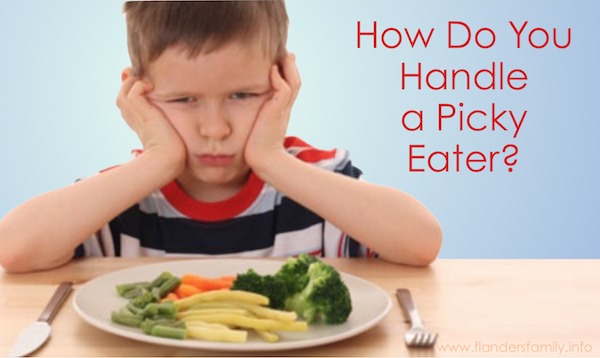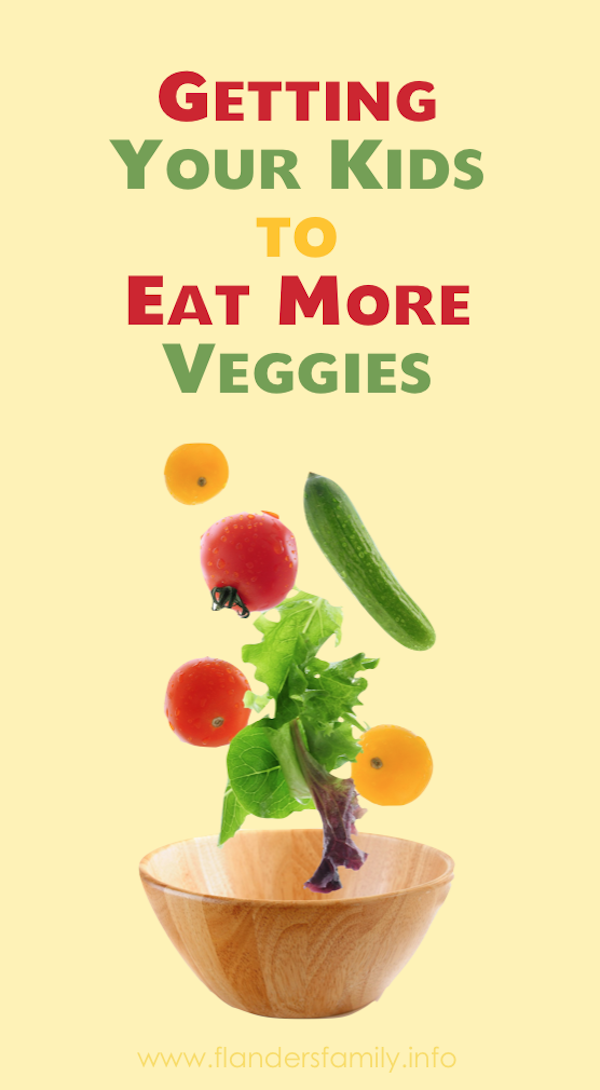How Do You Handle Picky Eaters?

Growing up, I had a friend whose mother would save whatever he refused to eat at one meal and serve it to him for the next. I don’t know about you, but I doubt I would recall my childhood very fondly if I’d routinely had the same bowl of soggy cereal set before me for several meals running. I’m so grateful my mother chose a different tack.
Anytime I was reluctant to eat something she served, she’d encourage me to try “just one bite.” Who knows? Maybe someday I’d discover that I liked it.
She hoped that, given enough one-bite attempts, I’d eventually develop a taste for the new dish, but in the meantime, she didn’t force things. In fact, she didn’t even insist I swallow those single bite samplings. I was allowed to spit it out if I found my taste for a particular dish still hadn’t changed. There were plenty of other options on the table. And if nothing there appealed to my appetite, there would be another meal served a few hours later. No grazing on junk food in the interim.
Although I don’t think my mom and dad ever compiled a list of hard-and-fast rules regarding mealtimes, they adhered to some guiding principles, which my husband and I have tried to follow in raising our own children. These may be summed up as follows:
How We Handle Picky Eaters:
Avoid junk
Junk food is high in calories and low on nutrition — and the companies that sell it have done extensive research to make it as addictive as possible. Any efforts to train your children to eat whole, healthful foods will fall flat if you stock your pantry with high fat, high sugar, high salt alternatives and allow them to graze between meals.
Offer variety
Consistently put a variety of good, wholesome food in front of your children at mealtimes, including lots of fresh fruits and vegetables, and they will eventually learn to love most if not all of it. Set a good example for them to follow and don’t let your dinner hour turn into a time of contention.
Be patient
Your children’s food preferences will mature as they do. Encourage them to try new foods, but don’t try to force them to eat anything. That’s a battle you can’t win. If there is something you know your child particularly dislikes, pair it with a healthful option you know he’ll eat. I have one son who hates beans but loves salad, so anytime I make bean soup, I serve a big salad alongside it.
Don’t obsess
Don’t freak out if a friend or relative offers your child something he normally isn’t given at home. An occasional piece of candy or drink of soda will not completely undermine your child’s health or negate the good progress you’ve made toward establishing healthful eating habits — and you will both learn important lessons about gratitude and flexibility in the process.
Thanks to my parents’ efforts, I learned to like a wide variety of healthful foods from a young age, although it was not until I was an adult that I finally developed a fondness for green beans. Now they’re my favorite, but I had a hard time even swallowing “just one bite” as a child. I’d gag every time.
I’m so glad my parents took such a balanced approach to training my taste buds. They didn’t reward finicky-ness by catering to my every culinary whim, but neither did they try to break me of personal preferences by making battles over diet a hill on which to die. They suspected I would eventually come around — and they were right. Which is why we’ve tried to handle our picky eaters in much the same way.
More ideas for feeding your family
Love to cook? You can view a categorized list of my other recipe posts here: Our Favorite Recipes. Or — for even more Flanders family favorites, plus a wealth of ideas for making mealtime memorable — get a copy of my book Sit Down & Eat.
Have enough nutritious and delicious recipes to fill a book of your own? Then grab a copy of my new devotional journal for culinary artists, Bread of Heaven so you can put them all down in one place.
PLEASE NOTE: This post contains affiliate links. If you make a purchase through any of those links, we may receive a small referral fee, at no extra cost to you. Such fees help defray the cost of running this website. This, in turn, allows us to continue offering our readers a wealth of FREE printable resources. So thank you for your support!












1. When filling plates for toddlers and preschoolers—if it’s on my plate, it’s on theirs. I think a lot of parents assume their kids won’t eat something so they don’t even offer it, which creates picky eaters.
2. They don’t have to eat all of it, and they don’t have to like it, but they do have to take one bite and swallow it. I don’t allow them to spit food out unless it’s actually inedible (spoiled, etc.). They’re allowed to tell me something tastes bad as long as they’re not rude about it.
3. Trying new foods or revisiting foods they don’t like yet is always met with praise. I clap and cheer a lot at dinner. My husband is a little picky and is careful to not influence what our girls think of different foods.
4. Dessert and second portions are only allowed if they’ve cleaned their plate. If this means all you have for dinner is a piece of buttered bread and a single green pea, this was your choice, not mine.
This has worked well for us so far. There are some things I still can’t get them to like (rice, for example). But there are no tantrums or hunger strikes at dinner. I also love how impressed people are when they see my small daughters get excited over steamed broccoli, grilled shrimp, and fresh strawberries.
My parents had similar rules, Abigail, except that I was allowed to spit out something I couldn’t swallow, for which I’m thankful, since green beans gagged me every time as a kid. Now green beans are my favorite and I eat them all the time. Proof that “Try a bite… you may change your mind” really works!